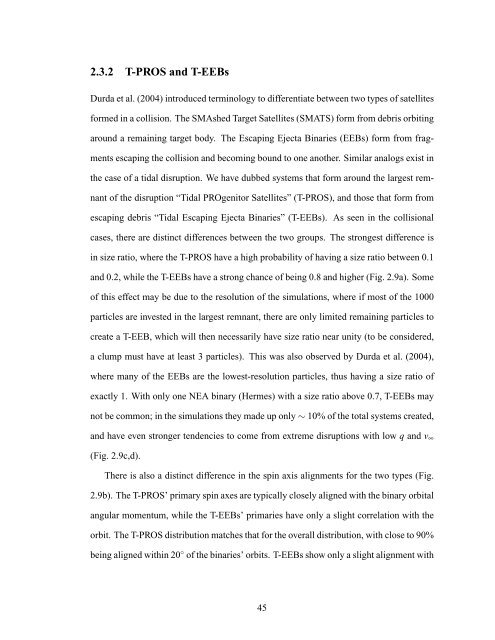Forming Binary Near-Earth Asteroids From Tidal Disruptions
Forming Binary Near-Earth Asteroids From Tidal Disruptions
Forming Binary Near-Earth Asteroids From Tidal Disruptions
Create successful ePaper yourself
Turn your PDF publications into a flip-book with our unique Google optimized e-Paper software.
2.3.2 T-PROS and T-EEBsDurda et al. (2004) introduced terminology to differentiate between two types of satellitesformed in a collision. The SMAshed Target Satellites (SMATS) form from debris orbitingaround a remaining target body. The Escaping Ejecta Binaries (EEBs) form from fragmentsescaping the collision and becoming bound to one another. Similar analogs exist inthe case of a tidal disruption. We have dubbed systems that form around the largest remnantof the disruption “<strong>Tidal</strong> PROgenitor Satellites” (T-PROS), and those that form fromescaping debris “<strong>Tidal</strong> Escaping Ejecta Binaries” (T-EEBs). As seen in the collisionalcases, there are distinct differences between the two groups. The strongest difference isin size ratio, where the T-PROS have a high probability of having a size ratio between 0.1and 0.2, while the T-EEBs have a strong chance of being 0.8 and higher (Fig. 2.9a). Someof this effect may be due to the resolution of the simulations, where if most of the 1000particles are invested in the largest remnant, there are only limited remaining particles tocreate a T-EEB, which will then necessarily have size ratio near unity (to be considered,a clump must have at least 3 particles). This was also observed by Durda et al. (2004),where many of the EEBs are the lowest-resolution particles, thus having a size ratio ofexactly 1. With only one NEA binary (Hermes) with a size ratio above 0.7, T-EEBs maynot be common; in the simulations they made up only ∼ 10% of the total systems created,and have even stronger tendencies to come from extreme disruptions with low q and v ∞(Fig. 2.9c,d).There is also a distinct difference in the spin axis alignments for the two types (Fig.2.9b). The T-PROS’ primary spin axes are typically closely aligned with the binary orbitalangular momentum, while the T-EEBs’ primaries have only a slight correlation with theorbit. The T-PROS distribution matches that for the overall distribution, with close to 90%being aligned within 20 ◦ of the binaries’ orbits. T-EEBs show only a slight alignment with45












